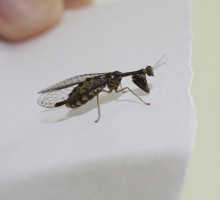
Mantidflies are in the family Mantispidae. This fascinating group of creatures aren’t actually flies at all – they are close relatives of lacewings. Their enlarged front legs are used to capture small insects for consumption, and their elongated prothroax makes them look a bit giraffe-like. This was the first mantidfly I’ve ever found in my garden, and I was completely fascinated by it. Mantidflies are largely nocturnal predators. The larvae of the subfamily to which this species of mantidfly likely belongs (Mantispinae) feed exclusively on spider eggs. You can’t get more beneficial than that in my book!
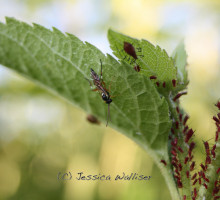
The Heliopsis in my garden is completely infested with aphids. It happens every year. This might seem like a bad thing – but it’s not. I know the Heliopsis will survive the onslaught (it always does) and allowing the plant to play host to the aphids means an increase in all the predators that naturally keep pest numbers down throughout my garden. Here is a fine example of exactly that. The little wasp you see here is an aphid parasitoid. She will lay a single egg inside an aphid. The resulting larva will consume the aphid, leaving only a swollen, brown exoskeleton behind (commonly called an aphid mummy). Eventually the larva pupates within the aphid, chews a circular hole in the back of the aphid, and emerges as an adult. Then the cycle begins anew. It’s pretty incredible stuff – and it wouldn’t be happening if I got rid of the aphids myself. Sometimes it’s difficult to let things ‘be’ – but when you do, something amazing could be the result
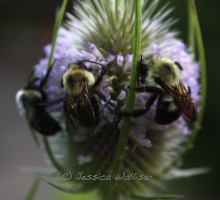
On a visit to the garden last evening, I found these three bumble bees sleeping on a teasel flower. They were sluggish and didn’t mind each other’s company. During the day they can become territorial, but when nighttime strikes, they seem to enjoy hanging out together
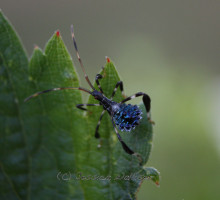
We were picking blueberries today when I spotted this tiny insect. At first I thought it was the nymph of a pest-munching assassin bug, but then I spotted its knife-like mouthpart (called a rostrum) inserted into an unripe blueberry. I knew then it was a vegetarian and not an assassin. I couldn’t resist this little leaf-footed bug’s iridescent blue coloration and ran for the camera. Though leaf-footed bugs are plant eaters (or suckers, rather) they don’t really do any significant damage. Notice this little nymph’s enlarged back legs? Now you know where the name leaf-footed bug comes from!
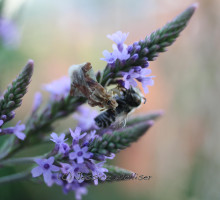
At first I only noticed a little bee clinging to this blue vervain (Verbena hastata) in the outdoor gardens at Phipps Conservatory and Botanical Garden in Pittsburgh. As I got closer, I noticed that the bee was too still to be alive. I touched it gently with my finger and it quickly scuttled away – but not on its own six legs! The jagged ambush bug (Phymata sp.) that had captured the bee ran around the stem to keep me from stealing his lunch. He wasn’t happy with my camera’s lens only an inch away, but he stood still long enough for me to take a few shots. I find a few dozen ambush bugs in my own garden every season. They are tough to spot because they are well camouflaged and only about a third of an inch long. I find them most often on, or in, a flower – lying in wait to ambush their prey
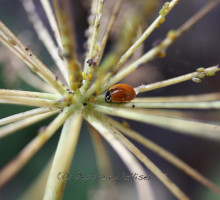
Today I made a quick trip to the Trial Gardens at North Park here in Pittsburgh. They were looking very nice! While I was there, I found this beautiful little polished ladybug (Cycloneda munda) hunkered down in the center of an aphid-infested Angelica bloom. How lucky for her to be surrounded by so many little snacks!
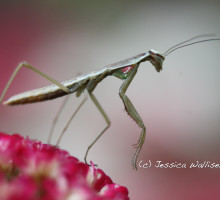
A few short weeks ago the praying mantid egg case I purchased at a local plant nursery hatched out hundreds of young mantids. When they first appeared, they were a mere quarter inch long. I found this one today and he is already an inch long. Notice the drop of water clinging to his “armpit”? Since it hasn’t rained here in quite some time, the droplet must be dew. These Chinese mantids are one of two common species found here in the East. The other is the European mantid. Both, as you can probably tell from their names, are imported species. Here in the U.S., we have about 20 native mantid species with only the Carolina mantid being found here in Pennsylvania (and only rarely at that). Most native mantids are southern species
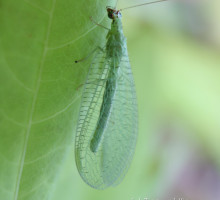
I discovered this lovely green lacewing clinging to a flowering tobacco leaf this morning. Though I often see them flying around my outdoor lights at night, I seldom see them during the day. Their larva are predators of aphids, whiteflies, thrips, and other garden pests and the adults enjoy sipping nectar from flowers at night. I love the lacy wings, metallic eyes, and slender antennae of this very good bug!